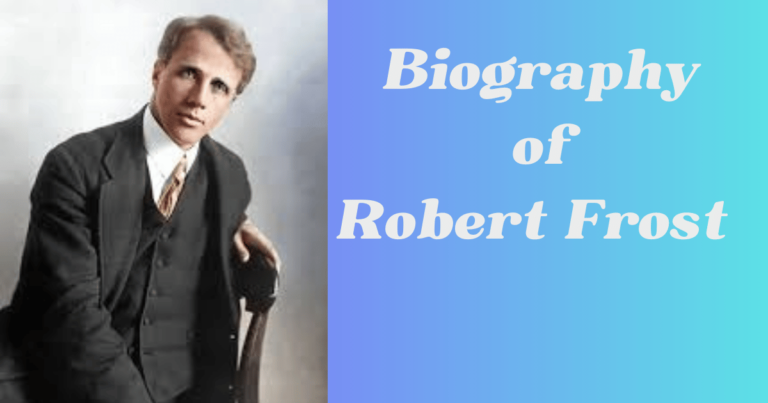Robert Frost remains one of the most celebrated poets in American history. Known for his evocative depictions of rural life and his mastery of language, Frost’s works have a timeless appeal that captivates readers across generations. But what shaped the man behind the poetry? This biography dives into the milestones of Robert Frost’s life, offering an insightful glimpse into the story of a literary legend.
What to Expect:
This blog post will walk you through Frost’s life and legacy (Robert Frost biography), answer frequently asked questions about him, and provide a helpful data table summarizing key moments in his life for quick reference. Whether you’re a history buff, a student researching Frost’s life, or a fan of his poetry, this guide will enrich your understanding of the man behind the verses.
Table of Contents
Robert Frost biography
1. Early Life and Education
Robert Frost was born on March 26, 1874, in San Francisco, California. His father, William Prescott Frost Jr., was a journalist, while his mother, Isabel Moody, was a Scottish immigrant who instilled in Robert a deep appreciation for literature.
When Robert was just eleven, his father passed away from tuberculosis, and the family relocated to Massachusetts. These formative years in New England greatly influenced Frost’s later works. Frost excelled academically, graduating as co-valedictorian in high school alongside his future wife, Elinor Miriam White.
While Frost enrolled at Dartmouth College, he quickly realized that academic life wasn’t suited for him. He left after less than a year and took on various jobs, from teaching to working as a factory worker, all the while nurturing his passion for writing.
2.Early Publications
Frost’s first published poem, “My Butterfly,” appeared in the New York Independent in 1894. This marked the official beginning of his career in poetry. Despite a promising start, Frost struggled for years to gain recognition and financial stability for his work. His perseverance during this period shaped the tenacity and depth we see in his poems.
3. Career Highlights
Frost’s literary success began to take shape after he and his family moved to England in 1912. This geographical leap turned out to be pivotal for his career.
- 1913 – Published his first collection, A Boy’s Will, receiving significant attention from British critics.
- 1914 – Released North of Boston, which included iconic poems such as “Mending Wall”. It solidified his reputation and brought him back to America as a literary luminary.
After returning to the U.S., Frost became a symbol of American poetry. Over the years, his acclaim only grew, highlighted by four Pulitzer Prizes for Poetry, an honor unmatched by any other American poet.
4. Major Works
Some of Frost’s renowned poetry collections include:
- A Boy’s Will (1913)
- North of Boston (1914)
- Mountain Interval (1916)
- New Hampshire (1923) – which won his first Pulitzer Prize
- Collected Poems (1930)
- A Further Range (1936) – earning him another Pulitzer Prize
His works often depict rural landscapes, complex human emotions, and philosophical reflections. Poems like “The Road Not Taken,” “Stopping by Woods on a Snowy Evening,” and “Birches” remain staples of literary study and pop culture.
5. Personal Life
Frost’s life wasn’t without hardship. Although he achieved monumental success as a poet, his personal life was riddled with tragedy. He and Elinor White had six children, but only two outlived their parents, and Frost endured the loss of his wife in 1938.
Despite these challenges, Frost found solace in his work and spent much of his later life lecturing at schools like Harvard and Dartmouth while receiving countless honors.
A Data-Table Summary of Robert Frost’s Life:
| Date | Event |
|---|---|
| March 26, 1874 | Born in San Francisco, California |
| 1885 | Relocated to Massachusetts after his father’s death |
| 1894 | Published his first poem, My Butterfly |
| 1912 | Moved to England, beginning his literary breakthrough |
| 1913 | Published debut poetry collection, A Boy’s Will |
| 1924 | Won the Pulitzer Prize for New Hampshire |
| 1938 | Lost his wife, Elinor White Frost |
| January 29, 1963 | Passed away in Boston, Massachusetts |
This snapshot captures the most significant milestones in Frost’s life, showcasing his progression from a struggling writer to one of America’s most revered poets.
FAQ about Robert Frost
When did Frost start writing poetry?
Frost began writing poetry during his high school years but gained public recognition only later in life, with the publication of “My Butterfly” in 1894.
What are Robert Frost’s most famous poems?
Some of his most famous poems include “The Road Not Taken,” “Stopping by Woods on a Snowy Evening,” “Mending Wall,” and “Birches.”
How many Pulitzer Prizes did Robert Frost win?
He won four Pulitzer Prizes— for New Hampshire (1924), Collected Poems (1931), A Further Range (1937), and A Witness Tree (1943).
What inspired Frost’s poetry?
New England’s rural landscapes, universal human experiences, and personal struggles were profound influences on Frost’s work.
How did Frost view the meaning of *“The Road Not Taken”?
Many interpret the poem as celebrating individuality; however, Frost himself saw it as a subtle critique of overanalyzing life choices.
What was Robert Frost’s educational background?
Frost briefly attended Dartmouth College and Harvard University but did not earn a college degree.
Frost’s Lasting Impact on Literature
Robert Frost’s unmatched ability to thread universal themes through accessible language has firmly cemented his position in literary history. His works continue to resonate with readers, offering solace, reflection, and a celebration of life’s complexities.
Whether through his meticulously observed New England settings, his philosophical undertones, or his rich language, Frost’s poetry bridges the everyday and the profound.
For readers eager to discover more about Frost and his work, engaging with his full poetry collections or biographical studies is a treasure trove of insights waiting to be unlocked.

